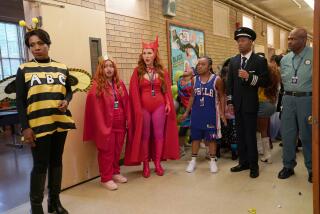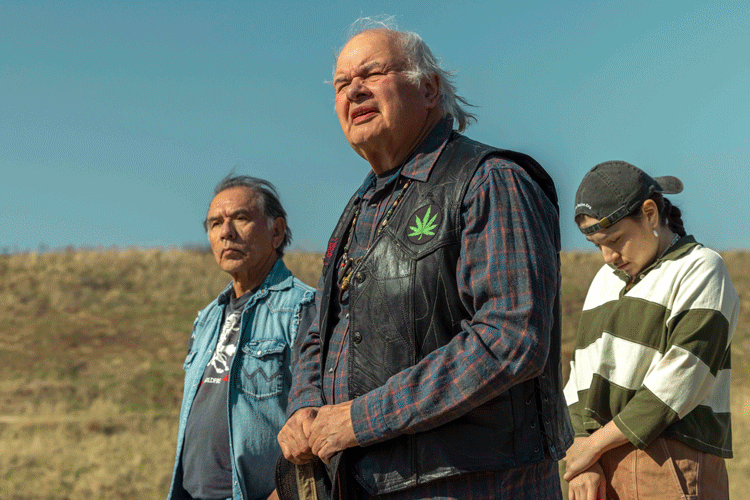TV Tropes identifies where you’ve seen it all before
- Share via
Some people take care of orchids. Others take care of guinea pigs. Barbara takes care of tropes.
Most of the day she’s a 51-year-old seamstress in Illinois and a caregiver for her husband. But in her spare time, Barbara tends to four tropes: “Cool Bike,” “Badass Longcoat,” “You Fail Logic Forever” and “Silly Reason for War.”
“They were a mess, they needed to be cleaned up, and nobody else was doing it, so I adopted them,” she says. “It’s equivalent of wiping down the sink every morning after I brush my teeth.”
Her obsession takes place at the website TV Tropes (tvtropes.org), a catalog of thousands of pop culture tropes -- conventions or devices that pop up repeatedly in storytelling. Each trope has a Web page listing examples, not only from television but also film, theater, literature, comic books, professional wrestling and other media.
TV Tropes is a wiki -- a site anyone in the world can contribute to and edit, like Wikipedia. Since its founding in 2004, more than 42,000 people have volunteered to be “tropers” like Barbara -- a mixture of fans, writers, educators and amateur academics smitten by pop culture and accessing their inner Joseph Campbell. The site now gets more than 2 million unique visitors a month, according to Google Analytics. Pop culture consumers know many of these tropes intuitively, even if they’ve never articulated them. For instance, one of Barbara’s, “Silly Reason for War,” is when a war grows out of a laughably trivial dispute and eventually becomes a lesson on intolerance. The trope’s 50-some examples include the film “Duck Soup,” the novel “Gulliver’s Travels,” episodes of “South Park” and “Star Trek” and the Web comic “Sluggy Freelance,” in which a war was “waged partly because the king of Mercia said the Trent king’s mustache smelled like Parmesan.”
Many tropes are familiar, such as “Distressed Damsel” and “Pie in the Face.” Some are inspired by icons, such as “The Boo Radley” -- a mysterious loner who’s assumed to be creepy but actually has a heart of gold, named for the character in “To Kill a Mockingbird.”
The site has entire sections for hair tropes, kissing tropes and varieties of flashbacks. Race tropes point out media stereotypes, such as “Where Da White Women At,” about how black men are portrayed as especially attracted to Caucasian women, named for a line in “Blazing Saddles.” Porn tropes include “Pizza Boy Special Delivery” and “Deus Sex Machina.” There’s a section called “Troper Tales,” about the ways tropes have shown up in the tropers’ real lives. All of these elements mesh into a messy, fascinating exploration of the engine that drives audiences to consume stories. TV Tropes is Aristotle’s “Poetics” for the digital age.
Know your tropes
The site’s founder is a 55-year-old computer programmer near Rice Lake, Wis., named Fast Eddie -- not his real name but his online “handle,” which he asked to use for this article for fear that drawing too much attention to himself would go against the site’s collaborative spirit. He thought up the site during a discussion on Buffistas.org, a community of “Buffy the Vampire Slayer” enthusiasts, a group of whom became the first tropers.
Eddie’s interest in tropes stems in part from his day job. “I think about how chunks of things fit together to make a whole,” he says. As in storytelling, programming has certain elements that are used over and over, such as a “model” or a “controller.” “If you’re not aware of how to wire those things together, you’re not going to make a fresh-feeling story, or you’re not going to solve your programming problem,” he says.
Since pop culture inevitably stirs up strong emotions, Eddie polices the site and its many discussion pages with five other moderators including Barbara, who goes by Madrugada online. The main divide is between “lumpers” and “splitters” -- those who prefer to group several ideas together into one trope, and those who try to break tropes into component parts.
Certain tropes become controversial. “Mary Sue” -- a character who’s too good -- became a battleground among fan fiction writers and fans, who take offense when their favorite characters are thought to have too few flaws to be interesting.
As it’s grown, the site has grappled with how to balance its identity as a resource for outsiders and a way for contributors to express themselves. Unlike the sober, evenhanded Wikipedia, TV Tropes is more informal and accepts a certain degree of subjectivity. The site has its own jargon, such as “phlebotinum,” defined as a “magical substance that may be rubbed on almost anything to cause an effect needed by a plot.”
The examples lean heavily toward fanboy interests, such as anime, comic books and science fiction; examples from theater, literature and classic films are lacking. The especially noisy anime contingent often clashes with other tropers over how much of their fanspeak to use. “I think that we’ve helped some folks widen their horizons beyond one show, one medium, one genre,” Eddie says. “That feels like a payoff when you’ve done that.”
TV Tropes also raises questions about the value of repeated patterns in fiction. Are tropes what audiences want to see, or what drives them away? Eddie says that tropes are not the same as clichés -- they only become clichéd if used too much. But the site sometimes comes across as a criticism of Hollywood’s addiction to the derivative. The overwhelming number of tropes -- about 20,000, Eddie estimates -- can make writing seem no different from welding pipes together.
Jane Espenson, who has written for “Buffy the Vampire Slayer,” “Gilmore Girls” and other shows, writes in an e-mail that “it would sting a little if I saw a story that I’d worked hard on labeled as too-familiar,” but that the site overall’s goal appears to be “not just figuring out why something feels too familiar, but implicitly cheering on the attempts to be truly original.”
Observers are mixed on whether the site can be helpful for writers. The screenwriting guru Robert McKee, who recently started a site for writers at storylogue.com, says writers should see the site as a list of clichés to avoid. “Let’s say you’re writing a horror film, you click on ‘horror’ -- the ‘abandoned hospital, the ‘abandoned playground,’ an ‘ancient tomb,’ ” he says, listing the tropes. “I would make certain that none of these are in my movie.”
When tropes do occur, he says, writers should try to reinvent them by staying true to the characters, “so that I create a way that they can go through the air conditioning vent [to escape] in a way that has never been done before. What the hell would that be?”
Richard Walter, the chairman of screenwriting at UCLA, is more skeptical of the site’s usefulness. “As soon as you start to generalize, categorize, you’re moving out of the heart and into the head,” he says. Writing, he says, is a more a spontaneous process of discovering what your characters say and do as you write, rather than thinking it through ahead of time.
Espenson notes that there are “moments during the writing of a scene that feel as if the ideas are coming to you from somewhere outside yourself. But there is usually very little magic during the ‘plotting’ of a script. This is more likely to be a thoughtful, probably even labored process.” Still, she adds, “in practice, working writers are generally very aware of these tropes already . . . I think the site would probably be of most use to writers who are just starting out.”
Jason Mittell, a professor of media studies at Middlebury College who has contributed to TV Tropes, says the site reflects a recent trend in which television audiences are becoming more aware of the mechanics of storytelling, through their exposure to intricately plotted shows like “Lost” and “24.”
“Tvtropes.org highlights that much of the fun is to watch not just what the story is but how it’s being told,” he says. “ ‘The Sopranos’ finale does that -- it asks you to decode it. . . . Much of the pleasure of ‘Seinfeld’ is we have these four plot lines set off at the beginning and how are these going to come together?”
Fast Eddie hopes that as the site grows, it will generate even greater insights into what makes for a good story. An admitted lumper, Eddie is searching for the “ur-trope” -- the one trope that can explain all others. And what’s his latest theory? “People tell stories,” he says.
More to Read
The complete guide to home viewing
Get Screen Gab for everything about the TV shows and streaming movies everyone’s talking about.
You may occasionally receive promotional content from the Los Angeles Times.






